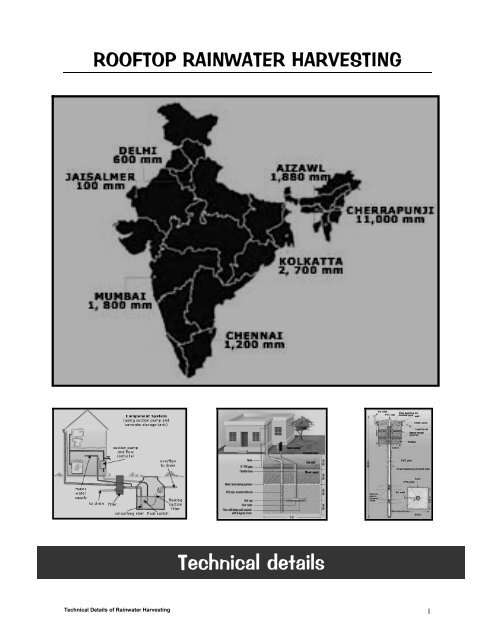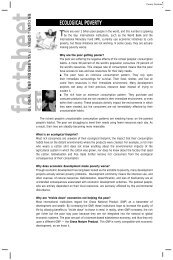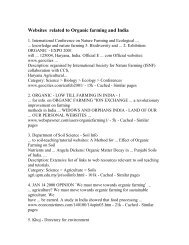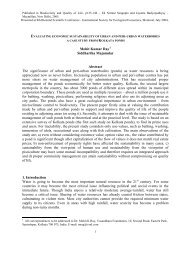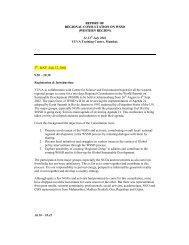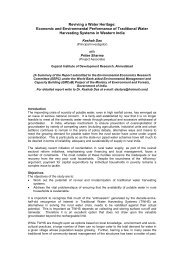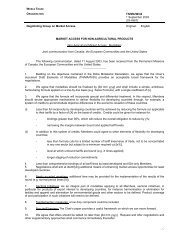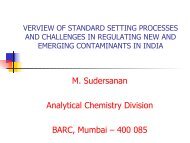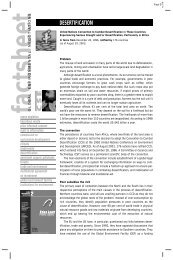Technical details - Rainwater Harvesting
Technical details - Rainwater Harvesting
Technical details - Rainwater Harvesting
Create successful ePaper yourself
Turn your PDF publications into a flip-book with our unique Google optimized e-Paper software.
ROOFTOP RAINWATER HARVESTING<br />
<strong>Technical</strong> <strong>details</strong><br />
<strong>Technical</strong> Details of <strong>Rainwater</strong> <strong>Harvesting</strong> 1
Rooftop <strong>Rainwater</strong> <strong>Harvesting</strong> System<br />
What is rainwater harvesting?<br />
<strong>Rainwater</strong> harvesting is the collection of raindrops. In most cases, a roof is used for this purpose. The<br />
rainwater then flows through the gutters, into a collection tank. The collected water can be used for smallscale<br />
irrigation (of vegetable gardens etc.), clothes washing, bathing and after treatment also for drinking and<br />
food preparation.<br />
Why <strong>Rainwater</strong>?<br />
<strong>Rainwater</strong> offers advantages in water quality for both irrigation and domestic use. <strong>Rainwater</strong> is naturally soft<br />
(unlike well water), contains almost no dissolved minerals or salts, is free of chemical treatment, and is a<br />
relatively reliable source of water for households.<br />
Why harvest rainwater?<br />
• Bangalore gets most of its drinking water from a distance of 95 kms. and a depth of 500 Mts.<br />
• A total of 858 million liters of water is being pumped every day to the city through the four Cauvery<br />
Stages.<br />
• The T G Halli Reservoir, the second source, responsible for 20 percent of city’s requirement (western<br />
parts of the city) has been dried up<br />
• Every drop of water supplied to city is through pumping done in three stages, which consumes 60<br />
percent of BWSSB’s total revenue towards power charges every month.<br />
• It makes ecological and financial sense not to waste a pure natural resource available in large quantity<br />
on one’s roof.<br />
• In the case of a homebuilder, at an initial stage of construction, investments in time, design and money<br />
are minimal for adopting roof rainwater harvesting.<br />
• Ground water sources are increasingly getting depleted or are getting polluted. Borewells are either<br />
silting up, getting short of water or are drawing polluted water.<br />
• Private purchase of water from tankers is unreliable in quality and is also expensive.<br />
• It encourages water conservation and self-dependence.<br />
• <strong>Rainwater</strong> collected and used on site can supplement or replace other sources of household water and<br />
prevent ground water depletion.<br />
The advantages of rainwater harvesting<br />
• One of the beauties of rainwater harvesting systems is their flexibility. A system can be as simple as a<br />
barrel placed under a rain gutter downspout for watering a garden or as complex as an engineered,<br />
multi-tank, pumped and pressurized construction to supply residential and irrigation needs.<br />
• <strong>Rainwater</strong> harvesting systems are integrated with the house, which makes the water easily accessible.<br />
• <strong>Rainwater</strong> harvesting systems are personal, which prevents arguments about who should take care of<br />
maintenance.<br />
• One time Installation cost, roughly some 2500 to 5000 Rs per system including a slow sand filter while<br />
sustainability of the construction is larger than that of a pump or well.<br />
• The used materials can be kept simple, are obtainable nearly everywhere at local (low) cost price.<br />
• The construction is easy and cheap in maintenance.<br />
<strong>Technical</strong> Details of <strong>Rainwater</strong> <strong>Harvesting</strong> 2
Facts about Bangalore<br />
• Population 6 Million<br />
• High altitude city 300 feet above sea level<br />
• No perennial river source nearby<br />
• Rapidly growing population<br />
• Increasing industrial demand<br />
• Traditional sources neglected<br />
• No pronounced aquifer<br />
• Pollution of ground and underground sources<br />
Main natural source of water for Bangalore is its lakes and tanks, which is reducing in numbers year by year.<br />
Lakes and tanks<br />
Year<br />
On of lakes and<br />
tanks<br />
1960 261<br />
1997 81<br />
2000 55<br />
Borewell drill leaves water table dry<br />
The unchecked sinking of Borewells has resulted in a sharp decline in a sharp decline in Bangalore’s water<br />
table, according to a survey conducted by the Central Ground Water Board (CGWB).<br />
The CGWB, which conducted the survey in April-May this year (2003), collected samples from over 104 test<br />
wells –both Borewells and open wells – in and around the city.<br />
The surveyors found more than 50 percent of the wells had gone dry and the water level in other wells had<br />
dropped by an average of over five meters.<br />
The increasing demand for water the unrestricted growth of the city erratic supply of water and the current<br />
dry spell has resulted in panic drilling of Borewells, which has caused depletion of the water table the only<br />
way to improve ground water levels ls by harvesting rainwater.<br />
Water level * in wells in the past 3 years<br />
Location May 2001 May 2002 May 2003<br />
Dasanapura 16.59 22.90 31.74<br />
Hebbal 14.41 13.48 14.22<br />
Yelahanka 23.11 22.53 25.29<br />
Indiranagar 02.25 ------ 10.71<br />
Jayanagar 06.51 07.83 08.65<br />
Lalbagh 02.41 02.67 02.66<br />
All readings are from ground to the surface of water.<br />
*In meters<br />
<strong>Technical</strong> Details of <strong>Rainwater</strong> <strong>Harvesting</strong> 3
Rainfall pattern in Bangalore<br />
Month Days Mm<br />
Jan 0.2 2.70<br />
Feb 0.5 7.20<br />
Mar 0.4 4.40<br />
Arp 3.0 46.30<br />
May 7.0 119.60<br />
Jun 6.4 80.80<br />
Jul 8.3 110.20<br />
Aug 10.0 137.00<br />
Sep 9.3 194.80<br />
Oct 9.0 180.40<br />
Nov 4.0 64.50<br />
Dec 1.7 22.10<br />
Total 59.8 970.00<br />
With Bangalore having about 60 rainy days in a year, it is<br />
estimated that residences with a 100 sq. m roof can gather<br />
about 97,000 litres of water per annum which will take care of<br />
the water needs for about 200 day<br />
Maximum<br />
rainfall occurs<br />
between June<br />
and Nov of the<br />
year<br />
The Bangalore Mahanagara Palike has<br />
decided to adopt this technology in parks<br />
and gardens. Considering the fact that<br />
the city has 400 parks, the savings on<br />
water costs will be enormous. The<br />
Government is also considering making<br />
the harvesting system mandatory in all<br />
new construction projects (both<br />
residences and commercial).<br />
Possible collection<br />
Year<br />
Rainy Rainfall<br />
days (mm)<br />
liters/100sq.m)<br />
1990 42 509.40 40,752<br />
1991 65 1338.50 1,07,080<br />
1992 56 844.60 67,568<br />
1993 65 1059.70 84,776<br />
1994 45 587.10 46,968<br />
1995 61 1072.20 85,776<br />
1996 64 1173.30 93,864<br />
1997 52 717.40 57,392<br />
1998 68 1431.80 1,14,544<br />
1999 52 1009.40 80,720<br />
Average 57 974.34 mm 77,947<br />
80% capture efficiency<br />
Area of roof X height of rainfall<br />
100sq.m X 9.7434 mt = 974.34cu.mt<br />
(97,434 lts)<br />
80% of capture efficiency =77947 lts<br />
How much water do we use?<br />
Use Liters/person Percentage<br />
Drinking 3 2.23%<br />
Cooking 4 2.96%<br />
Bathing 20 14.81%<br />
Flushing 40 29.63%<br />
Washing clothes 25 18.51%<br />
Washing utensils 20 14.81%<br />
Gardening 23 17.03%<br />
Total 135 lts 100%<br />
We use major part (80%) pure<br />
drinking water for flushing,<br />
washing clothes & utensils and<br />
gardening. For these purpose one<br />
can use harvested rainwater<br />
It is possible to collect rainwater in Bangalore throughout the year and use the same for:<br />
Gardening, car washing and domestic non-potable purpose like washing clothes, dishes, bathing, toilet, swabbing the<br />
floor, etc<br />
For all purposes including potable purpose i.e. drinking<br />
<strong>Technical</strong> Details of <strong>Rainwater</strong> <strong>Harvesting</strong> 4
<strong>Technical</strong> Description<br />
A rooftop rainwater harvesting system consists the following elements:<br />
• Collection area,<br />
• Conveyance system,<br />
• Filtration /treatment<br />
• Storage<br />
• Usage/ Recharge<br />
The collection area in most cases is the roof of a house or a building. The effective roof area and the<br />
material used in constructing the roof influence the efficiency of collection and the water quality.<br />
A conveyance system usually consists of gutters or pipes that deliver rainwater falling on the rooftop to<br />
cisterns or other storage vessels. Both drainpipes and roof surfaces should be constructed of chemically<br />
inert materials such as wood, plastic, aluminum, or fiberglass, in order to avoid adverse effects on water<br />
quality.<br />
The water ultimately is stored in a storage tank or cistern, which should also be constructed of an inert<br />
material. Reinforced concrete, fiberglass, or stainless steel are suitable materials. Storage tanks may be<br />
constructed as part of the building, or may be built as a separate unit located some distance away from the<br />
building.<br />
Requirements<br />
• Most effective process has been proven to be to start with an example and then spread the technology<br />
around the area. It is therefore nessecary to spread information and knowledge.<br />
• When incomes are very low among members of the target group one can make use a finance system<br />
like a bank, a savings deposit of a farmers or womens group. Of course an outside finance programme is<br />
suitable but personal inputs enhance the 'bond' with the construction and thus strengthens the<br />
sustainability.<br />
• Someone is to teach the members of the target group how to construct a rainwater harvesting<br />
installation. This person or these people shall have to be very enthusiastic rather than skillful and able to<br />
reflect this upon the target group.<br />
<strong>Technical</strong> Details of <strong>Rainwater</strong> <strong>Harvesting</strong> 5
Design Tips<br />
Design your roof well for rainwater collection<br />
A flat roof can be gently sloped to drain water towards the storage system. A 'nahani trap' or 'floor trap' can<br />
be placed at the time of casting the roof just near the inlets of the down water pipes<br />
Sloping roofs should have a gutter of PVC or zinc sheet to collect water & channel it to the down water pipe<br />
system.<br />
Roofs should be uncluttered & should be easy to clean by sweeping & swabbing if necessary.<br />
Down water pipes should be designed well<br />
90mm dia. PVC pipes resistant to UV rays appear to be the best bet as downwater pipes. Of course, this<br />
depends upon the roof area to be drained.<br />
3 to 4 downwater pipes seem sufficient for 1000 to 1200 sft area<br />
Filter the rainwater before storage<br />
Filtering can be as basic as a floor trap placed before the water enters the downwater pipe or a piece of<br />
sponge placed at the inlet of the downwater pipe<br />
• a PVC bucket with gravel, sand & charcoal is a good filter before rainwater is stored<br />
• a PVC drum with sponge at the inlet & outlet is also a filter<br />
• a small two chamber inspection/ filter tank can also be devised<br />
Try to determine your storage system at the planning stage itself.<br />
Would it be a:<br />
• Roof level storage tank<br />
• Ground level drum or masonry tank<br />
• Below the ground sump<br />
• Partially below ground and partially above ground tank<br />
Locate the storage system properly<br />
• Roof level storage tanks may need to be at the rear of the house or on the sides so that it is neither<br />
obtrusive nor visually offensive.<br />
• Ground level drums or tanks occupy space and should not hinder movement or appear unsightly.<br />
• Below the ground sump is a good option since most new constructions in Bangalore go in for sumps<br />
anyway. Sumps are hidden from view, less costly to build and do not obstruct movement.<br />
Note: always provide for an outlet for excess collection of water from the storage system<br />
Further treatment of excess rainwater<br />
It is a common perception that water stored for long goes bad. If water does not contain any organic material<br />
and if it is stored in a clean container it can stay for a long time.<br />
Some small treatment like ‘alum dosing’ or ‘chlorination’ can also be done to stored water to improve its<br />
quality.<br />
Addition of a small quantity of alum dissolved in half a bucket of water will bring down the suspended solids<br />
and clear the stored rainwater.<br />
<strong>Technical</strong> Details of <strong>Rainwater</strong> <strong>Harvesting</strong> 6
Similarly adding a small quantity of bleached powder to half a bucket of water and then mixing it with the<br />
stored rainwater will kill bacterial contamination.<br />
Great care should be exercised while chlorinating and it is not particularly recommended.<br />
It is always recommended that water used for drinking should be boiled and filtered invariably.<br />
and cooking but only after boiling and filtering the water.<br />
<strong>Technical</strong> Details of <strong>Rainwater</strong> <strong>Harvesting</strong> 7
Tanks<br />
The size of the tank is dependent of the amount and purpose of the water but also of the annual rainfall and<br />
the size of the roof. A normal sized tank for a roof of 20 to 40 square metres is 10 cubic metres.<br />
All rainwater tank designs should include as a minimum requirement:<br />
• A solid secure cover<br />
• A coarse inlet filter<br />
• An overflow pipe<br />
• A manhole, sump, and drain to facilitate cleaning<br />
• An extraction system that does not contaminate the water; e.g., a tap or pump<br />
• A soak away to prevent spilled water from forming puddles near the tank<br />
Additional features might include:<br />
• A device to indicate the amount of water in the tank<br />
• A sediment trap, tipping bucket, or other "foul flush" mechanism<br />
• A lock on the tap<br />
• A second sub-surface tank to provide water for livestock, etc<br />
Plastic tanks:<br />
Available as finished products in various capacities. The cost of these tanks ranges from Rs 2/litre to about<br />
Rs 3.5/litre.<br />
Conduits<br />
Conduits are pipelines or drains that carry rainwater from the catchment or rooftop area to the harvesting<br />
system. Conduits can be of any material like polyvinyl chloride (PVC) or galvanized iron (GI), materials that<br />
are commonly available.<br />
The following table gives an idea about the diameter of pipe required for draining out rainwater based on<br />
rainfall intensity and roof area:<br />
Sizing of rainwater pipe for roof drainage<br />
Diameter<br />
Average rate of rainfall in mm/h<br />
Of pipe<br />
(mm) 50 75 100 125 150 200<br />
50 13.4 8.9 6.6 5.3 4.4 3.3<br />
65 24.1 16.0 12.0 9.6 8.0 6.0<br />
75 40.8 27.0 20.4 16.3 13.6 10.2<br />
100 85.4 57.0 42.7 34.2 28.5 21.3<br />
125 - - 80.5 64.3 53.5 40.0<br />
150 - - - - 83.6 62.7<br />
mm/ h - millimeters per hour; m - meters<br />
<strong>Technical</strong> Details of <strong>Rainwater</strong> <strong>Harvesting</strong> 8
Filters and separators<br />
Despite the roof being higher than the ground, dust and other debris can be blown onto it, especially if the<br />
roof is near to a roadway. Leaves can also fall onto the roof from nearby trees and flying and climbing<br />
animals can defecate upon it. The quality of water can be much improved if this debris is kept out of the<br />
system. To accomplish this filters and separators can be added to a rainwater harvesting system at the inlet,<br />
outlet or both. Filters simply remove the debris and allow all water to flow; separators remove the debris and<br />
wash it away in a portion of the water.<br />
The first line of defence is a course leaf filter. The filter can be installed anywhere from the gutter to the<br />
entrance to the tank. The most popular positions are in the gutter, at the beginning of the downpipe, in the<br />
downpipe, in the ground before the tank and at the entrance to the tank itself. Of these, the tank entrance is<br />
by far the most common in very low cost systems.<br />
Whatever location is chosen for the filter, there are several criteria that should be met for good design:<br />
• The filter should be easy to clean or largely self-cleaning<br />
• It should not block easily (if at all) and blockages should be obvious and easy to rectify<br />
• It should not provide an entrance for additional contamination<br />
The cost should not be out of proportion with the rest of the system - user surveys have shown that people in<br />
southern Uganda will only spend about 5% of the cost of the system on filtering, users in Sri Lanka will spend<br />
closer to 10%.<br />
Contaminants from a roof are usually concentrated in the first run off from the roof. After this runoff has<br />
passed and washed the roof the water is considerably safer. The amount to be removed varies and a<br />
number of studies have had differing results. Despite this uncertainty, first flush systems are a popular<br />
method of improving the quality of roof runoff prior to storage, particularly in Asian countries. There are<br />
basically four methods of separating the first flush;<br />
1.Manual, 2. Fixed volume, 3. Fixed mass and, 4. Flow rate.<br />
The manual method is the simplest and widely recommended it does, however rely on the user both being<br />
home and prepared to go out into the rain to operate the device much reducing its usefulness.<br />
The fixed volume method, which relies on the water simply filling a chamber of a set size (usually a length<br />
of downpipe) until it overflows, is the "automatic" method usually applied in low cost systems. The method<br />
can be used either with or without a floating ball seal which helps in reducing mixing between early dirty<br />
water and later clean water, however Michaeledes (1987) has found that this mixing is transient. They are<br />
also found with either automatic draining over a period of time or require manual draining. Manual draining<br />
systems have little to recommend them as if left to drain will not only fail to work for the next storm, but can<br />
cause additional pollutants to be washed in to the tank from the first flush device itself.<br />
The fixed mass system has also been promoted. The devices, usually relying on a mass of water to tip a<br />
bucket or seesaw tend to be unreliable and users inevitably disable the system. A newer first flush concept is<br />
to use the changes in flow rate over the course of a storm. Stormwater management designers have been<br />
using a flow rate model of first flush for some time to reduce the large land areas required for "volumetric"<br />
facilities. Australian Company has developed a system whereby flow rate is used for roof runoff. The<br />
SafeRain system balances the rate of water intake into a suspended hollow ball against its leakage, raising<br />
its weight and stretching its suspension until it descends into a recess, blocking the opening and allowing<br />
water into the tank. The system has the advantage of being self-cleaning and removes the need for any<br />
storage of the first flush water (and its subsequent drainage).<br />
Finer filtering can remove small sediment which would otherwise either be suspended in the water or settle<br />
to the bottom of the tank leaving a sludge. The techniques are well known, employing gravel, sand or fine<br />
screens but the needs of rainwater harvesting systems are unique, as in a tropical downpour flow rates can<br />
be very high - with short-term peaks of more than 1.5 l s -1 . This calls for either very large surface areas or<br />
courser screens. A filter consisting of a Ø300mm tube filled with 150mm sand on a bed of 200mm of pebbles<br />
has been used in Sri Lanka which copes with all but the very highest peak flows, however the filters were<br />
often bypassed or filled with courser material when user saw water overflowing the filter during heavy<br />
downpours.<br />
Another problem of fine filters is cleaning. As all water passes through most designs of fine filter, particles<br />
become trapped in the filter requiring periodic cleaning. If this is not carried out, the filter will eventually block<br />
<strong>Technical</strong> Details of <strong>Rainwater</strong> <strong>Harvesting</strong> 9
and simply overflow which has resulted in filters being emptied of media and abandoned. In developed<br />
countries self-cleaning filters are available with a fine mesh screen (typically 0.4mm). These screens use the<br />
first flow of water from a storm to flush the filter of debris or have a continual washing action using about 10%<br />
of the water. In VLC systems there is usually a significant overflow of water and these types may be viable if<br />
suitable filter mesh or cloth is available locally.<br />
Filters<br />
The filter is used to remove suspended pollutants from rainwater collected over roof. A filter unit is a chamber<br />
filled with filtering media such as fibre, coarse sand and gravel layers to remove debris and dirt from water<br />
before it enters the storage tank or recharge structure. Charcoal can be added for additional filtration.<br />
Source: A water harvesting manual for urban areas<br />
Charcoal water filter<br />
A simple charcoal filter can be made in a drum or an earthen pot. The<br />
filter is made of gravel, sand and charcoal, all of which are easily<br />
available.<br />
Sand filters<br />
Sand filters have commonly available sand as filter media. Sand<br />
filters are easy and inexpensive to construct. These filters can be<br />
employed for treatment of water to effectively remove turbidity<br />
(suspended particles like silt and clay), colour and microorganisms.<br />
Source: A water harvesting manual for urban areas<br />
In a simple sand filter that can be constructed domestically, the top<br />
layer comprises coarse sand followed by a 5-10 mm layer of gravel<br />
followed by another 5-25 cm layer of gravel and boulders.<br />
Dewas filters<br />
Most residents in Dewas, Madhya Pradesh, have<br />
wells in their houses. Formerly, all that those wells<br />
would do was extract groundwater. But then, the<br />
district administration of Dewas initiated a<br />
groundwater recharge scheme. The rooftop water<br />
was collected and allowed to pass through a filter<br />
system called the Dewas fillter, designed by Mohan<br />
Rao, district collector of Dewas, and engineers of the<br />
rural engineering services. The water thus filtered is<br />
put into the service tubewell.<br />
The filter consists of a polyvinyl chloride (PVC) pipe<br />
140-mm in diameter and 1.2m long. There are three<br />
chambers. The first purification chamber has<br />
pebbles varying between 2-6 mm, the second<br />
chamber has slightly larger pebbles, between 6 and 12 mm and the third chamber has the largest - 12-20<br />
mm pebbles. There is a mesh at the outflow side through which clean water flows out after passing through<br />
the three chambers. The cost of this filter unit is Rs 600.<br />
Varun: S Vishwanath, a Bangalore water-harvesting expert, has developed a rainwater filter "VARUN".<br />
According to him, from a decently clean roof 'VARUN' can handle a 50-mm per hour intensity rainfall from a<br />
50 square meter roof area. This means the product is relatively standardised. For new house builders we<br />
therefore can recommend the number of downpipes they have to optimise on and the number of filters they<br />
will need.<br />
<strong>Technical</strong> Details of <strong>Rainwater</strong> <strong>Harvesting</strong> 10
'VARUN' is made from a 90-litre High-Density polyethylene (HDPE) drum. The lid is turned over and holes<br />
are punched in it. This is the first sieve, which keeps out large leaves, twigs etc. <strong>Rainwater</strong> coming out of the<br />
lid sieve then passes through three layers of sponge and a 150-mm thick layer of coarse sand. Presence of<br />
sponge makes the cleaning process very easy. Remove the first layer of sponge and soak /clean it in a<br />
bucket of water (which you then don't waste but use it for plants). The sand needs no cleaning at all. The<br />
basic cost of the filter is about Rs 2250/-<br />
<strong>Technical</strong> Details of <strong>Rainwater</strong> <strong>Harvesting</strong> 11
Recharge structures<br />
<strong>Rainwater</strong> may be charged into the groundwater aquifers through any suitable structures like dugwells,<br />
Borewells, recharge trenches and recharge pits.<br />
Various recharge structures are possible - some which promote the percolation of water through soil strata at<br />
shallower depth (e.g., recharge trenches, permeable pavements) whereas others conduct water to greater<br />
depths from where it joins the groundwater (e.g. recharge wells). At many locations, existing structures like<br />
wells, pits and tanks can be modified as recharge structures, eliminating the need to construct any structures<br />
afresh. Here are a few commonly used recharging methods:<br />
1. Recharging of dugwells and abandoned tubewells.<br />
<strong>Technical</strong> Details of <strong>Rainwater</strong> <strong>Harvesting</strong> 12
In alluvial and hard rock areas, there are thousands of wells which have either gone dry or whose water<br />
levels have declined considerably. These can be recharged directly with rooftop run-off. <strong>Rainwater</strong> that is<br />
collected on the rooftop of the building is diverted by drainpipes to a settlement or filtration tank, from which it<br />
flows into the recharge well (borewell or dugwell).<br />
If a tubewell is used for recharging, then the casing (outer pipe) should preferably be a slotted or perforated<br />
pipe so that more surface area is available for the water to percolate. Developing a borewell would increase<br />
its recharging capacity (developing is the process where water or air is forced into the well under pressure to<br />
loosen the soil strata surrounding the bore to make it more permeable).<br />
If a dugwell is used for recharge, the well lining should have openings (weep-holes) at regular intervals to<br />
allow seepage of water through the sides. Dugwells should be covered to prevent mosquito breeding and<br />
entry of leaves and debris. The bottom of recharge wells should be desilted annually to maintain the intake<br />
capacity.<br />
Providing the following elements in the system can ensure the quality of water entering the recharge wells:<br />
1. Filter mesh at entrance point of rooftop drains<br />
2. Settlement chamber<br />
3. Filter bed<br />
2. Settlement tank (chamber)<br />
Settlement tanks are used to remove silt and other floating<br />
impurities from rainwater. A settlement tank is like an ordinary<br />
storage container having provisions for inflow (bringing water from<br />
the catchment), outflow (carrying water to the recharge well) and<br />
overflow. A settlement tank can have an unpaved bottom surface to<br />
allow standing water to percolate into the soil.<br />
In case of excess rainfall, the rate of recharge, especially of<br />
borewells, may not match the rate of rainfall. In such situations, the desilting chamber holds the excess<br />
amount of water till it is soaked up by the recharge structure. Thus, the settlement chamber acts like a buffer<br />
in the system.<br />
Any container, (masonry or concrete underground tanks, old unused tanks, pre-fabricated PVC or<br />
ferrocement tanks) with adequate capacity of storage can be used as a settlement tank.<br />
3. Recharging of service tubewells.<br />
In this case the rooftop runoff is not directly led into the service tubewells, to avoid chances of contamination<br />
of groundwater. Instead rainwater is collected in a recharge well, which is a temporary storage tank (located<br />
near the service tubewell), with a borehole, which is shallower than the water table. This borehole has to be<br />
provided with a casing pipe to prevent the caving in of soil, if the strata is loose. A filter chamber comprising<br />
of sand, gravel and boulders is provided to arrest the impurities.<br />
4. Recharge pits<br />
A recharge pit is 1.5m to 3m wide and 2m to 3m deep. The excavated pit is lined with a brick/stone wall with<br />
openings (weep-holes) at regular intervals. The top area of the pit can be covered with a perforated cover.<br />
Design procedure is the same as that of a settlement tank.<br />
5. Soakaways / Percolation pit<br />
Percolation pits, one of the easiest and most effective means of harvesting rainwater, are generally not more<br />
than 60 x 60 x 60 cm pits, (designed on the basis of expected runoff as described for settlement tanks), filled<br />
with pebbles or brick jelly and river sand, covered with perforated concrete slabs wherever necessary.<br />
6. Recharge trenches<br />
A recharge trench is a continuous trench excavated in the ground and refilled with porous media like<br />
pebbles, boulders or broken bricks. A recharge trench can be 0.5 m to 1 m wide and 1 m to 1.5 m deep. The<br />
length of the recharge trench is decided as per the amount of runoff expected. The recharge trench should<br />
<strong>Technical</strong> Details of <strong>Rainwater</strong> <strong>Harvesting</strong> 13
e periodically cleaned of accumulated debris to maintain the intake capacity. In terms of recharge rates,<br />
recharge trenches are relatively less effective since the soil strata at depth of about 1.5 metres is generally<br />
less permeable. For recharging through recharge trenches, fewer precautions have to be taken to maintain<br />
the quality of the rainfall runoff. Runoff from both paved and unpaved catchment can be tapped.<br />
7.Recharge troughs<br />
To collect the runoff from paved or unpaved areas draining out of a compound, recharge troughs are<br />
commonly placed at the entrance of a residential/institutional complex. These structures are similar to<br />
recharge trenches except for the fact that the excavated portion is not filled with filter materials. In order to<br />
facilitate speedy recharge, boreholes are drilled at regular intervals in this trench. In design part, there is no<br />
need of incorporating the influence of filter materials.<br />
This structure is capable of harvesting only a limited amount of runoff because of the limitation with regard to<br />
size.<br />
8. Modified injection well<br />
In this method water is not pumped into the aquifer but allowed to percolate through a filter bed, which<br />
comprises sand and gravel. A modified injection well is generally a borehole, 500-mm diameter, which is<br />
drilled to the desired depth depending upon the geological conditions, preferably 2 to 3 m below the water<br />
table in the area. Inside this hole a slotted casing pipe of 200-mm diameter is inserted. The annular space<br />
between the borehole and the pipe is filled with gravel and developed with a compressor till it gives clear<br />
water. To stop the suspended solids from entering the recharge tubewell, a filter mechanism is provided at<br />
the top.<br />
<strong>Technical</strong> Details of <strong>Rainwater</strong> <strong>Harvesting</strong> 14
Maintenance<br />
<strong>Rainwater</strong> harvesting systems require few skills and little supervision to operate. Major concerns are the<br />
prevention of contamination of the tank during construction and while it is being replenished during a rainfall.<br />
Contamination of the water supply as a result of contact with certain materials can be avoided by the use of<br />
proper materials during construction of the system. The main sources of external contamination are pollution<br />
from the air, bird and animal droppings, and insects. Bacterial contamination may be minimized by keeping<br />
roof surfaces and drains clean but cannot be completely eliminated. If the water is to be used for drinking<br />
purposes, filtration and chlorination or disinfection by other means (e.g., boiling) is necessary. The following<br />
maintenance guidelines should be considered in the operation of rainwater harvesting systems:<br />
• A procedure for eliminating the "foul flush" after a long dry spell deserves particular attention.<br />
The first part of each rainfall should be diverted from the storage tank since this is most likely to<br />
contain undesirable materials, which have accumulated on the roof and other surfaces between<br />
rainfalls. Generally, water captured during the first 10 minutes of rainfall during an event of<br />
average intensity is unfit for drinking purposes. The quantity of water lost by diverting this runoff<br />
is usually about 14l/m 2 of catchment area.<br />
• The storage tank should be checked and cleaned periodically. All tanks need cleaning; their<br />
designs should allow for this. Cleaning procedures consist of thorough scrubbing of the inner<br />
walls and floors. Use of a chlorine solution is recommended for cleaning, followed by thorough<br />
rinsing.<br />
• Care should be taken to keep rainfall collection surfaces covered, to reduce the likelihood of<br />
frogs, lizards, mosquitoes, and other pests using the cistern as a breeding ground. Residents<br />
may prefer to take care to prevent such problems rather than have to take corrective actions,<br />
such as treating or removing water, at a later time.<br />
• Gutters and downpipes need to be periodically inspected and cleaned carefully. Periodic<br />
maintenance must also be carried out on any pumps used to lift water to selected areas in the<br />
house or building. More often than not, maintenance is done only when equipment breaks down.<br />
• Households must establish a maintenance routine that will be carried out by family members.<br />
As has been noted, in some cases the rainwater is treated with chlorine tablets. However, in most places it is<br />
used without treatment. In such cases, residents are advised to boil the water before drinking. Where cistern<br />
users do not treat their water, the quality of the water may be assured through the installation of<br />
commercially available in-line charcoal filters or other water treatment devices.<br />
<strong>Technical</strong> Details of <strong>Rainwater</strong> <strong>Harvesting</strong> 15
Required materials<br />
• Rain. And really lots of it, throughout the year, favorably some two metres of it!<br />
• A catchment area, usually a roof of 15-20 square metres or above is sufficient.<br />
• Roof-gutters, those can consist of bent metal sheets or even large PVC pipes 'tubes' (the gutters should have a<br />
large enough capacity to prevent overflow during rainfall).<br />
• Pipelines or gutters (PVC) that lead from the roof-gutters to the storage tank.<br />
• Storage tank; because of the size (between 5.000 and 12.000 liters) a concrete, a Ferro cement or a PVC tank. Do<br />
mind that a manhole should be present for inside-cleaning purposes. And the outlet is situated at the bottom, it must<br />
remain accessible.<br />
Materials required for rainwater harvesting system<br />
No Material Size Rate<br />
1 Water pipe HDPE/PVC 50 – 150 mm dia pipe 15-30 Rs. (Running feet)<br />
2 PVC Tank 1000 ltrs Rs. 2.55 per liter<br />
3 Ferrocement tank 5000 ltrs Rs. 250 per liter<br />
4 Elbows & Tees 20.00 – 75.00<br />
5 Filter drum 700.00<br />
6 Filters 1500.00<br />
7 First flush 50 liters 750.00<br />
8 Motor pump<br />
9<br />
Ultraviolet light system<br />
water purifier<br />
½ HP (Kirloskar) 1800.00<br />
1 HP (Kirloskar) 3500.00<br />
8000.00<br />
<strong>Technical</strong> Details of <strong>Rainwater</strong> <strong>Harvesting</strong> 16
Costing<br />
<strong>Rainwater</strong> harvesting methods are site specific and hence it is difficult to give a generalised cost. But first of all, the major<br />
components of a rainwater harvesting system - rain and catchment area - are available free of cost. A good proportion of<br />
the expenses would be for the pipe connections. By judiciously fixing up the slopes of roofs and location of rainwater<br />
outlets, this could be brought down considerably. However the cost varies widely depending on the availability of existing<br />
structures like wells and tanks which can be modified and used for water harvesting.<br />
Typically, installing a water harvesting system in a building would cost between Rs 2,000 to 30,000 for buildings of about<br />
300 sq. m. The cost estimate mentioned above is for an existing building. For instance, water harvesting system in the<br />
CSE building in Tughlakabad Institutional Area, Delhi, was set up with an investment of Rs 30,000 whereas those in the<br />
model projects ranged between Rs 70, 000 and Rs 8 lakh. The costs would be comparatively less if the system were<br />
incorporated during the construction of the building itself.<br />
Some basic rates of construction activities and materials have been given here, which may be helpful in calculating the<br />
total cost of a structure. The list is not comprehensive and contains only important activities meant to provide a rough<br />
estimate of the cost.<br />
a. Unit cost of construction activities.<br />
Item Unit Rate (Rs.)<br />
Excavation in soils Cu. m. 90.00<br />
Excavation in rock Cu. m. 150.00<br />
Brickwork with cement mortar(1:6) Cu. m. 1400.00<br />
Plain cement concrete (1:3:6) Cu. m. 1500.00<br />
Reinforced cement concrete (1:2:4) Cu. m. 4700.00<br />
Including steel bars, shuttering etc. Cu. m. 4700.00<br />
PVC piping for rainwater pipes<br />
Making borehole in meter 165.00Soft soil<br />
(with 150 mm diameter PVC casing)<br />
110 mm diameter<br />
200 mm diameter<br />
165.00<br />
275.00<br />
Meter 180.00<br />
b. Ferrocement tanks with skeletal cage<br />
Total cost<br />
in rupees<br />
Capacity of rooftop water harvesting system in liters<br />
5,000 ltrs. 6,000 ltrs. 7,000 ltrs. 9,000 ltrs. 10,000 ltrs.<br />
12,430 12,975 13,970 14,380 15,800<br />
<strong>Technical</strong> Details of <strong>Rainwater</strong> <strong>Harvesting</strong> 17
Water conversation at a micro level<br />
(a) Close taps tightly. Fix leaking taps, pipes immediately and check regularly for leaks.<br />
(b) Replace damaged and leaking pipes, taps and valves to avoid overflow and wastage.<br />
(c) Choose plants that are drought-resistant. Water gardens during the coolest part of the day<br />
(d) Never put water down the drain when there mat be another use for it.<br />
(e) Wash vehicles with a bucket and sponge instead of hose, which uses 400 liters of water. By<br />
using a bucket upto 300 liters can be saved.<br />
(f) Wash vegetables in a bowl of water, washing the cleanest ones first. Use this water for your<br />
plants.<br />
(g) Collect rainwater in large tubs of cans and use it to water your plants.<br />
(h) A leaking toilet can waste up to 16,000 liters of water per year.<br />
(i) Don’t use your washing machine for one or two garments. Ensure you have a full load.<br />
(j) Harvest rainwater at home. Keep a large deep structure to collect rainwater for non-potable<br />
purposes. <strong>Rainwater</strong> harvesting is especially important in today’s scenario since it<br />
recharges the ground water levels.<br />
A collective effort will go along way in ensuring that the city does not suffer water shortages.<br />
Quick facts<br />
• You need 100 drops of water to fill a teaspoon<br />
• Less than 2 percent of the water on earth is freshwater. And most of that is locked up in the<br />
polar ice caps or is part of the ground water<br />
• More than five million people, most of them children, die each year from illness caused from<br />
drinking unsafe water<br />
• The privatisation of water industry a 400 billion dollar a year business globally one third<br />
larger than global pharmaceuticals<br />
• Every year, the average Briton uses 10,000 gallons of water, 500 percent more than average<br />
Indian does<br />
• The total wastewater generated in India is to the tune of 22900 million liters per day. Of this<br />
quantity a mere 5942 million liters per day is treated<br />
<strong>Technical</strong> Details of <strong>Rainwater</strong> <strong>Harvesting</strong> 18
RAINWATER HARVESTING Resource Pool<br />
No Person Organisation Address Ph No. Nature of resource<br />
1 Manjunath<br />
Environmental Management &<br />
policy research Institute<br />
Urban Eco-Park 100ft Road, Peenya Indl Area,<br />
3 rd Phase, Bangalore 560 058<br />
O – 8372460<br />
R – 3464418<br />
F – 8377745<br />
Trainer<br />
2 A. R. Shiva Kumar<br />
Karnataka State Council for<br />
Science & Technology<br />
3 K. Vishwanath <strong>Rainwater</strong> Club<br />
No. 44, Sourabha, Basaveshwara Layout<br />
Vijayanagar 2 nd Stage, Bangalore 560 040<br />
No, 264, 6 th Main, 6 th Block, B.E.L. Layout,<br />
Vidyaranyapura, Bangalore 560 097<br />
Email. Chitravishwanath@vsnl.com<br />
Website. www.rainwaterclub.org<br />
O – 3348848<br />
3341652<br />
R – 3398655<br />
F - 3461221<br />
O – 3641690<br />
3642435<br />
Trainer<br />
(Has done Research on<br />
<strong>Rainwater</strong> <strong>Harvesting</strong>)<br />
Architect<br />
(Has done Research on<br />
<strong>Rainwater</strong> <strong>Harvesting</strong>)<br />
4 Sudhakar Veronica Inc<br />
No 2/1, Meenakshi Koil Street, Shivajinagar<br />
Bangalore 560 051<br />
O – 2864767<br />
M – 94480 64767<br />
Engineer<br />
Companies involved in manufacturing rainwater harvesting system material<br />
No Contact Person Organisation Address Ph No. Material<br />
M.K. Birad+ar<br />
No 219, Kamaraj Road, Bangalore 560 042 O - 5361257<br />
(Engineer)<br />
<strong>Rainwater</strong> harvesting system<br />
1<br />
JAIN Irrigation System Lid.<br />
E mail: jislblr@hathway.com<br />
5548921<br />
Satish Kumar<br />
materials<br />
Website: www.jains.com<br />
F – 5548921<br />
(Office administrator )<br />
2 Anada Kumar<br />
Mathru Krupa<br />
No 1071, 8th main, 5th cross<br />
Vijayanagar Bangalore<br />
O – 3104545<br />
water purifier (Ultra violet light)<br />
3 Bindu<br />
Kisan Mouldings Ltd.<br />
(Kisan Barish rainwater system )<br />
O - 227 2425<br />
229 3226<br />
f – 227 2238<br />
<strong>Rainwater</strong> collection, storage, &<br />
rooftop harvesting systems<br />
<strong>Technical</strong> Details of RWH<br />
19


